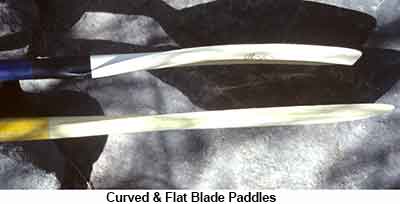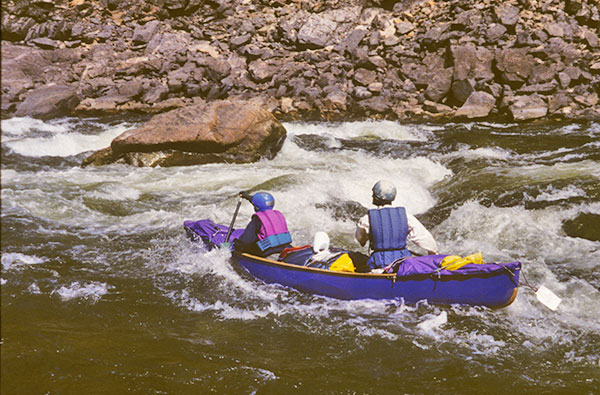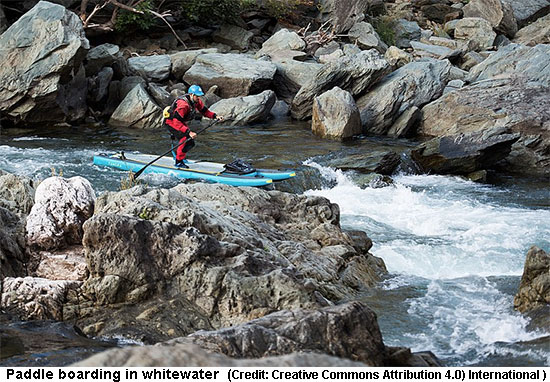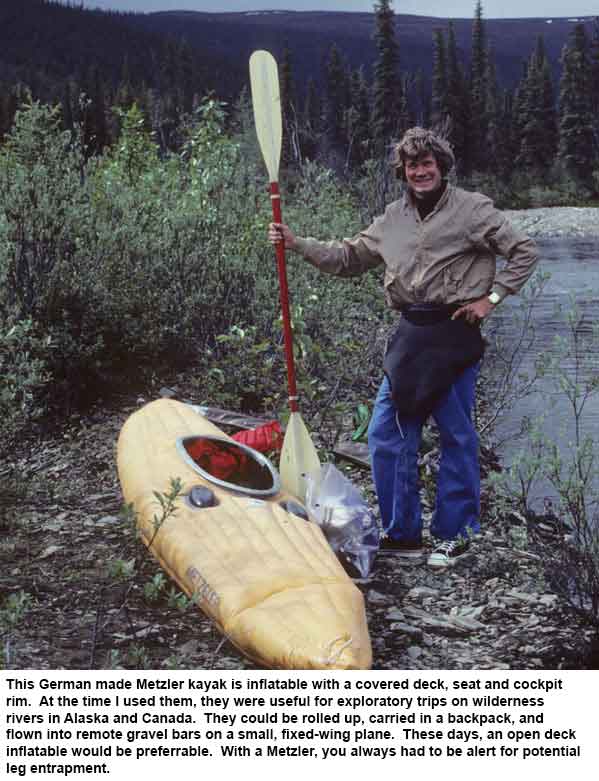Kayaks and Other Whitewater Craft
Ron Watters
From The Whitewater River Book: A Guide to Techniques, Camping and Safety. Copyright 1982 by Ron Watters. Revised 1996, 1998.
Note that the Whitewater River Book is now out of print, but I am putting together an updated, on-line version of the book which will be available on my web page. Other chapters available include: Planning Multi-day Rafting or Kayaking Trips and Rafts and Drift Boats.
Introduction
I slipped my legs into the cockpit and eased myself down into the seat of the British made kayak. Torkel, a Norwegian kayaker who was showing us down one of the many fine whitewater rivers in his country, smiled a broad, toothy grin and said, "Remember this river starts out pretty good." "Pretty good" was Torkel's modest way of saying "big, hairy rapids."
I was having grave doubts about the sanity of this broad-shouldered, smiling Norwegian. We already had heard some chilling tales about destroyed boats and aborted trips on the Sjoa River (pronounced "Shew-ah"), which tumbles out of the glaciated Jotunheimen mountains of central Norway.
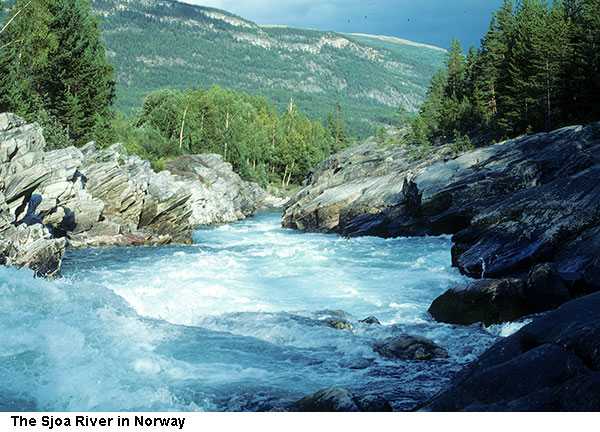
When I had first met Torkel at a Norwegian railway station, we had talked about a trip that he taken to the United States a few years before. While there he had parachuted off the sheer face of El Capitan in Yosemite National Park. The fact that he had jumped off a cliff three thousand feet above the valley floor did not do much to ease my nervousness as we pushed off.
Torkel was not kidding. The first rapid that rushed out of sight from the put-in point was obstructed by boulders and holes and demanded quick maneuvers. The river narrowed and dropped through several large curling-back holes. At the first break in the rapid in a small calm sport, Barney my boating companion from the States, washed in behind us upside down, attempted several rolls and finally came up before the next series of rapids which splashed out of sight around the bend.
The river continued its fast pace, with narrow chutes, boulder fields and drops into holes. My reservations about Torkel faded as I watched him smoothly and cautiously gliding back and forth, searching out eddies and stopping safely above major rapids that needed scouting. The river allowed kayaking at its best, with lots of maneuvering, continuous whitewater along the river's entire length and good places to stop to scout ahead.
The water was clear, pure enough to drink, and at times felt like champagne bubbles as we paddled through it. Waterfalls spilled over the canyon walls and lush verdant moss and vegetation clung to the polished boulders along the shore
The maneuverable kayak and its relative, the decked canoe or C-1, are the types of craft that make it possible to experience rivers like Norway's Sjoa. Years ago, to the south of Norway in Europe, the North American Eskimo kayak was adapted and found to be superbly maneuverable in the shallow, rocky streams characteristic of the Continent. Now, well-constructed kayaks made of durable plastics are used to challenge all types of whitewater rivers throughout the world.
Kayaks and Decked Canoes
The whitewater kayak has gone through a number of evolutions since the days when it was an Eskimo skin boat, sealed by the user's parka and utilized for hunting. Much of the early stage in the development of modern kayaks, the stage which took them from their hunting origins to today's glass and plastic boats, occurred in Europe. The result is a boat which is the lightest and the most maneuverable of craft for running whitewater.
In international whitewater competition, kayaks are classified as K-1 which means "a kayak for one person." In fact, they are even more specific using the designation K1M for men's competition and K1W for women's competition. You are probably wondering why even use K-1 since you typically think of a kayak being paddled by one person. Actually, they can be built for and paddled by two people. In past years, there was a K-2 classification, a kayak for two people, but that has been eliminated from Olympic competition.
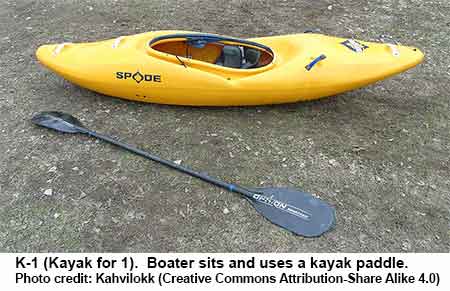
Also as maneuverable as the K-1 is the decked canoe or C-1. Decked means that the boat is fully covered, looking much like a kayak, as opposed to the traditional "open" canoe which doesn't have a deck. In a C-1, the canoeist kneels and uses a single-bladed paddle. A kayaker, however, sits with legs extended under the deck and uses a double-bladed paddle. Because the paddler is kneeling, a canoe is slightly larger and more buoyant than a kayak.
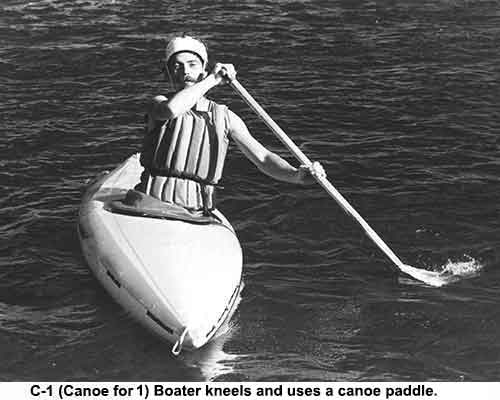
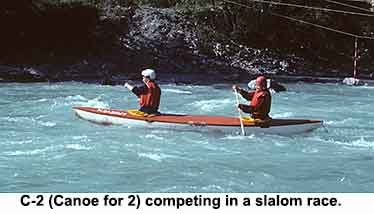 And, yes, there was a C-2 canoe as you can see from the photo to the right, but like K-2, the C-2 is no longer supported in Olympic competition.
And, yes, there was a C-2 canoe as you can see from the photo to the right, but like K-2, the C-2 is no longer supported in Olympic competition.
Both whitewater kayaks and decked whitewater canoes are constructed with a rim around the cockpit on which a spray skirt can be attached, completely sealing out water. With a special technique, both crafts can be rolled back to an upright position if they are knocked over in whitewater. (See the chart below for a generalized comparison of the two boats.)
Pros & Cons of Kayaks & Decked Canoes:
| Advantages | Disadvantages | |
| Whitewater Kayak (K-1) | Quick, maneuverable, and able to run the most technical of whitewater. Can be rolled upright in an upset. Can run very shallow, small rivers and streams. Efficient paddling with a double-bladed paddle. Good bracing ability on both sides to prevent flips. Low center of gravity provides good dynamic stability. | At first, the kayak is unstable, and a beginner may take some swims. Low volume boats can be cramped and uncomfortable. Remote possibility of legs becoming entrapped if boat is pinned. Boater sits lower than in a C-1, and thus the kayaker cannot see so much while on the river |
| Whitewater Decked Canoe (C-1) | Higher than a kayak: canoers can see more in rapids. Little danger of becoming pinned under the deck because of the kneeling position. A typical C-1 carries more gear than a kayak. Good boat for large boaters. Very strong bracing and powerful strokes on the paddling side. |
At first the C-1 is unstable and swims can be expected by a beginner because of the kneeling position. Paddling is done on one side, leaving the other side vulnerable; more difficult to keep upright than a kayak if tipped in that direction. Forward paddling slightly less efficient than with a kayak. |
Other Types of Kayaks: Sit-on-Top & Inflatables
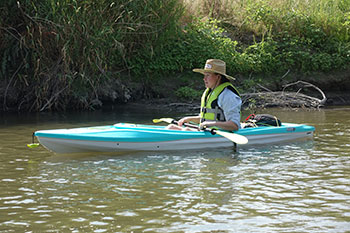 Since we are on the topic of different types of kayaks, I should point out that kayaks are also available without a covering deck. The generic term used to describe them is "sit-on-top" kayaks. In fact, there are more of these types of kayaks floating around than the traditional covered kayak. They are reasonably priced and made of various tough plastic materials, but they are generally not designed for whitewater. Some users will paddle them through minor rapds, but they are otherwise best used on lakes and easy going rivers.
Since we are on the topic of different types of kayaks, I should point out that kayaks are also available without a covering deck. The generic term used to describe them is "sit-on-top" kayaks. In fact, there are more of these types of kayaks floating around than the traditional covered kayak. They are reasonably priced and made of various tough plastic materials, but they are generally not designed for whitewater. Some users will paddle them through minor rapds, but they are otherwise best used on lakes and easy going rivers.
Rounding out the ever increasing array kayaks are inflatable kayaks. These are almost always open without a covered deck, but one manufacture has produced an covered inflatable kayak on which a spray skirt can be attached. More about this interesting specimen and other inflatable kayaks at the end of this article.
Kayak Design
Volume. Kayak volume, measured in gallons, gives a general idea how buoyant and roomy a kayak is. Low volume boats (under 65 gallons) are good choices for women and children. Medium volume boats (around 70 gallons, give or take a few gallons) are good all around boats for men and women. They are responsive and play well. Large volume boats (85 gallons or more) are good for heavier boaters and those who will be going on multi-day trips.
Rob Lesser, who has made a number of first descents of extremely difficult rivers, recommends that a kayaker in the 180- to 200-pound range use a larger-volume, more buoyant boat. A heavy kayaker makes a less buoyant boat ride lower in the water than it should, making the boat lose some of the handling characteristics it was designed for.
Many boaters, particularly Europeans, feel that larger volume, more buoyant boats are best for rivers with big hydraulics. Larger volume boats also are more stable and good for beginners. On the other hand, points out Ken Horwitz, new designs have changed hull design and deck-to-hull distances resulting in low and medium volume kayaks with a high degree of maneuverability- yet with reasonable buoyancy. A number of good kayakers running big water rivers feel that the extra maneuverability is an important safety factor.
It should also be mentioned that one type of low volume boat, called a squirt boat, has become popular among kayakers and cancers. Sleek and barely large enough for a boater to squeeze in, they are highly unstable. Yet their instability is their attraction: they can be popped up, flipped end over end or maneuvered into other prized play positions.
Some on-line product reviews classify kayaks according to low, medium, and high volumes, giving prospective buyers an idea of how much space is available inside. If you have the opportunity, by all means try different sized boats and select the one that works best for you.
Rocker. If the hull of a kayak is viewed from the side, a wide arch is outlined beginning at the bow, curving down to the ground and back up to the stern. This curvature is called rocker. On a simplistic level, the more rocker a boat has, the less the ends drag in the water and the easier it is to turn. It is possible to go overboard with too much rocker, but all whitewater kayaks are designed with a reasonable amount of rocker to enable them to maneuver adequately in rapids.
Length and Width. In the past, the width and length of almost all boats conformed to standards set by an international racing committee: minimum width for kayaks is 60 centimeters (23.6 inches) and for C-1 s is 70 centimeters (27.6 inches). The length standard for a kayak is 4 meters (13.1 feet). Recreational boats, however, need not follow these standards and most manufacturers these days produce kayaks which are must shorter than racing standards.
Other Design Features. Different types of kayakers prefer different designs for their personal style and the type of rivers they run. Rob Lesser recommends a kayak with a low-cut cockpit area. This allows the kayaker greater mobility for leaning, bracing, and rolling than a cockpit that is higher. Lesser thinks the low cockpit is particularly important in the type of roll he advocates in which a boater lies back against the rear deck of the kayak at the conclusion of the roll.
Most kayaks have now moved to a large cockpit which allows a boater to eject quicker from the kayak. With such cockpits the kayaker can pull up his knees and drop out. It has made kayaking much safer, particularly in situations where a boat is pinned against a rock.
Choosing a Kayak for Your Needs. By using different shapes of hulls and decks, boat designers can create kayaks to fulfill radically different requirements. For instance, kayaks for down river racing (also called wild-water racing) are streamlined with typically deep V-shaped hulls and little, if any, rocker.
Kayaks also are designed for whitewater slalom racing, sea cruising, and other purposes. But for recreational whitewater use, three categories are of importance: whitewater play-boats, whitewater touring kayaks, and squirtboats.
Tom Derrer, a boat designer, explains that whitewater play boats are shorter boats with varying designs, which are ideally suited for surfing and playing in waves and holes in rapids. This type of boat has become the most popular kayak. Squirt boats, mentioned previously, are an extreme type of play boat with the lowest volume. They can't carry much more than a sponge and sandwich and aren't for the beginner, but for the thrill seeker they can't be beat.
Whitewater touring kayaks for years have been, and will continue to be, an all around boat for whitewater. With volumes in the medium and high ranges, they are good for day outings and can carry extra gear for overnight or multi-day kayaking
Some people who plan to run minor whitewater and flat rivers or lakes may be interested in casual recreation boats. These boats can run, though sluggishly, up to class III whitewater. Whitewater slalom racing boats also should be briefly mentioned. They are designed specifically for slalom racing and thus are small, unstable and very responsive
Kayak Materials
At one time, almost all kayaks were made from fiberglass. With the introduction of plastic materials, that's changed. Recreational whitewater kayaks are now manufactured primarily from polyethylene plastic. Though polyethylene has taken over the recreational market, racing kayaks are still made of fiberglass (or fiberglass-like materials such as Kevlar). As one would expect from a racing craft, glass boat lay ups are lighter and move faster across the water than polyethylene boats. But, the big draw back from a recreational standpoint is the durability of fiberglass.
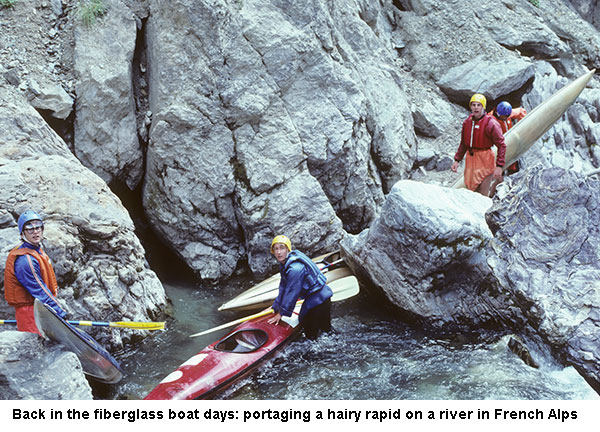
A couple of decades ago, kayakers spent about as much time repairing their boats as they did running rivers. Once during the fiberglass era, I had to do a quick repair of my kayak in a campground late one night on the way to the river. All I had for light was a dim flashlight, but I finally managed to get the patch in place. From then on as long as I used the boat, I could recognize that particular patch by the green pine needles perfectly preserved in fiberglass.
I wasn't the only one. Now and then I'd run into other boaters with bits of dirt, grass, or even dog hair preserved in the fiberglass
It is nice not to have worry about repairs. In fact, plastic boats are so strong that they can be dropped, dragged and hammered in the most unmerciful ways without damaging them. When I finished running the Alsek River in the glaciated St. Elias Range of Alaska and Canada, I took my plastic kayak and folded it so it would fit in our pick-up plane. The pilot took great delight in standing on the crushed boat while I wrapped duct tape around the ends to keep it from unfolding. Later in Juneau when it was unfolded, a crease was all that remained of the mishandling.
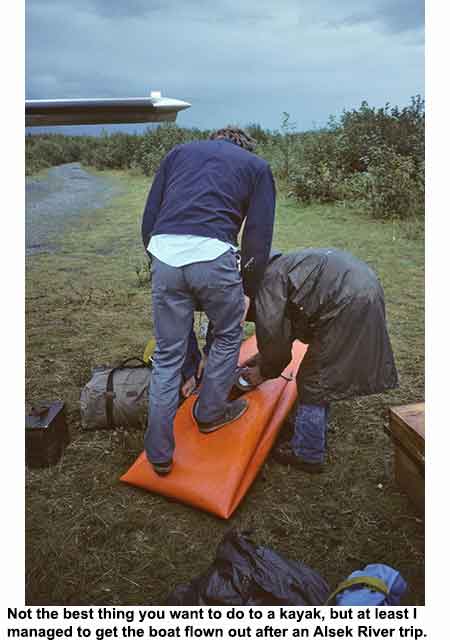
One of the problems with plastic is the possibility that if the kayak is broached and wrapped on a rock, the pliable plastic will collapse, entrapping the paddler. To prevent entrapment, manufacturers have gone to larger cockpits and placed foam walls or pillars in the kayak.
Pillars, however, are not total insurance that the boat will not collapse, but it is far better than no protection. Because of their importance, pillars should not be removed from a kayak. While entrapment is a potential danger in river running, most boaters using care on rivers will never experience it. Kayak manufacturers remind boaters to follow the acceptable safety practice of leaning into a rock.
If for any reason the boat begins to get caught and tipped upstream or begins to wrap, the kayaker should bail out immediately.
Bracing and Features
Foot Braces. Every kayak should have foot braces, which are usually two small pedals mounted on each side inside the boat to enable the boater to brace himself securely. Foot braces that can be adjusted by a spring-loaded lever are by far the best. Although rare now, every so often one runs into poorly designed braces which need to be adjusted by pins or screws and require a boater to crawl head first into the cramped kayak usually going through numerous contortions to try to adjust them.
The Europeans have developed a bulkhead foot brace, which consists of foam covered aluminum or another material which is cut to fit inside the kayak. The bulkhead, on which the feet are braced, provides a secure platform for the feet. It prevents the situation in which the boat collides head on with a rock, knocking the kayaker off the foot peddles and forcing him farther in the boat. In severe cases, a kayaker can be jammed so tightly in his boat that he becomes entrapped. Normally, this situation is not a major problem, but these braces are not a bad idea for those planning to run rocky, steeply dropping rivers.
Knee, Thigh, and Hip Braces. Various types of knee, thigh, and hip bracing systems are incorporated into kayaks to provide the boater with a tight, secure fit. To paddle, roll, and run whitewater effectively, the anchoring system is essential. The tight fit transforms the boater's body motions to the boat. It is possible to add foam to existing kayaks to beef up the bracing system.
River supply companies sell custom outfitting kits of foam padding which can be cemented in place so it conforms to the hips and the outside of the thighs. Additional padding extends from the knee braces to the inside of the mid thighs, creating an extensive bracing system and giving the boater superb control. The one caution with any bracing is to be sure you easily can come out of the boat if for some reason you need to.
Seat. The seat should be comfortable and snug. In some kayaks, different-sized seats are available. If they are not, you easily can make the seat more snug by cementing in foam padding to the sides of the boat near your hips.
Other Features. An important feature on all boats are grab loops on the bow and stern of the kayak, which are necessary for tying the kayak to cartop carriers or pulling a capsized boat to shore. A number of kayaks also have broach loops which is a cable on the top deck within reach of the boater.
It also can be used for rescue or with a lock, to help prevent theft. A very comfortable addition to a kayak is a padded back band which can snapped into place behind the seat. During a day of boating, instead of leaning back against the hard rim of the kayak, you rest against the padding of the back band. Look for a back band that can be moved out of place easily for gear storage.
Building a Kayak
If you don't mind forgoing the convenience and durability of plastic, you can build your own boat out of fiberglass. Kayaks made from fiberglass and its relatives such as Kevlar are lighter and faster than plastic boats. Once you get the hang of it, fiberglass is not a difficult medium to work with, and some kayakers still build their own boats. Now and then boating clubs have boat building workshops and clinics, and it is possible to do it on your own if you can borrow or rent a mold.
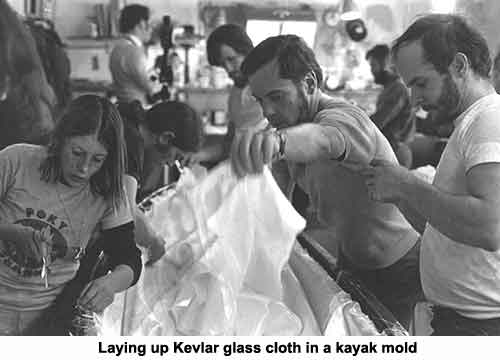
Briefly, the process of building a kayak begins with several layers of precut fiberglass cloth placed on a waxed mold. Resin is mixed and brushed on, saturating the cloth. A deck and hull are formed in this manner on the mold, allowed to harden, and removed from the mold. Then the deck and hull are seamed together and the cockpit rim, seat, and foot braces are attached.
The best book available for building kayaks and canoes is Charles Walbridge's Boatbuilder's Manual. Walbridge has done a wonderful job of keeping up with the latest materials and techniques and you'll want to have a copy.
Buying a Kayak
Before making a purchase, check with kayaking friends. Try out different types of boats. How comfortable you feel and how well you are braced in a kayak determine how the boat will respond for you. For recreational whitewater, it is wise to stay away from the hot slalom racing designs or wild-water or down river boats (see the "Kayak Design" section earlier in this chapter) and stick with whitewater play-boats or whitewater touring kayaks. If you take lessons, usually whitewater schools have a different models of kayaks that you can try.
Buying a used boat is a good way of getting started in kayaking without a large investment. Plastic boats have a long life, and even one that has been heavily used by the previous owner will have many years left. A plastic boat with the bottom deeply gouged may be still riverworthy but price should be accordingly adjusted.
One obvious defect you'll want to avoid is a leaky boat. It's not always apparent. To check for leaks, prop the boat up and fill it up with water from a garden hose. If it's a fiberglass boat, push on the hull and deck and see if any cracks show up. The fiberglass should flex and pop back in place. Reg Lake suggests putting your head inside a glass boat and holding it up to the sun. Flaws, fractures, and patches will show up as shadows. Sit in the boat. Does it feel comfortable? You can make it more comfortable by adding foam padding, but it will save you a lot of extra work if the boat feels good from the beginning.
Kayak Paddles
A kayak paddle is built with a blade on each end, offset 90 degrees or less to each other. The paddle must be rotated as the kayaker makes a stroke on each side. This arrangement helps cut down air resistance when paddling into strong winds and water resistance when paddling through big waves
Blades. Kayak paddles also are constructed with flat or curved blades. The great majority of kayakers use curve blades, but there's a few of us out there who still prefer flat. I like flat blades because there is no confusion about which side is the power face of the blade when paddling or rolling--and I feel my roll is more reliable and stronger with a flat-bladed paddle.
Nevertheless, curved blades are the most popular paddle by far. They slice into the water smoothly and the curved face provides power for technical river running and playing. Curved blades are available in an assortment of different types of curvature patterns. A recommended type of curved paddle is the dihedral, and according to Rob Lesser is efficient and helps in rolling technique.
Many curved blade paddles are offset less than 90 degrees which takes some paddling stress off the wrists and arms. Since the concave curve of the blade is the power face, this type can be confusing to a new paddler if he is disoriented underwater while getting ready for a role, but with a little practice, most beginning paddlers adapt easily.
Curve-bladed paddles are manufactured with "left" or "right" control. As you turn the paddle shaft with each stroke, one of your hands consistently does the turning while the other allows the shaft to rotate. If you turn it with your right hand, you are a right-handed paddler and need to buy a right-grip paddle. Left-handed paddlers use a left-grip paddle. The two are not interchangeable, and it is important to know the difference if you buy a curve-bladed paddle.
Since left grip paddles are not all that common, Tom Wilson, a boater and designer, suggests at the onset that beginners should learn to "control" or "grip" the paddle with the right handle since the right-grip paddle is easier to obtain. Other kayakers believe the control hand is something that develops naturally and whatever comes naturally is the way to go.
Wood or Synthetic. Wood kayak paddles are preferred by some paddlers because the wood feels good and has a warm touch, but they also demand extra care. Fiber-reinforced paddles that are made from epoxies, Kevlar, carbon fibers and other tough synthetics and that have wrapped aluminum shafts are among the strongest of paddles and require little care. Using injected, molded plastic paddles is a way to cut costs, but some of these paddles have breakage problems and they often do not feel so comfortable as other paddles.
Shaft. An important feature on any type of kayak paddle is an oval shaft. It provides a better grip than a round one and, by the feel, the paddler knows how the blade of the paddle is oriented as he makes strokes. I also prefer a shaft which is not slippery. Some shafts when wet practically pop out of your hands in waves, while the good ones are like rosin on a baseball bat and stay where they're suppose to be.
Length. In the past the size of the paddle was judged by the height of the kayaker. That's still true to some degree, but things have charged. In the past sizing from short paddles to long paddles ranged as much as 20 centimeters. Now the range is within 6 to 8 centimeters, with the most common sizes being 200, 202, 204 and 206 centimeters. Generally, a shorter person will go with a slightly shorter paddle, but it is not a hard and fast rule. Some prefer a paddle size according to the type of water that they run, using shorter paddles for steeply dropping, obstructed rivers and longer paddles for big water.
Longer paddles, above the 206 size, are the best choice for flat water kayaking or sea kayaking where a long lever arm created by the paddle is an advantage. Overall, however, in whitewater kayaking the trend has been to shorter paddles. It's largely due to the popularity of play boating and the associated techniques of catching waves, surfing and doing endos. A shorter paddle can be rotated at a faster rate making it easier to move in and out of eddies and waves. A good starting size is a 204 centimeter paddle, and you may wish to go up or down according to your preferences.
Spray Skirts
A spray skirt fits around the kayaker's waist and is attached to the rim of the cockpit by means of an elastic shock cord or rubber gasket. The most common and most 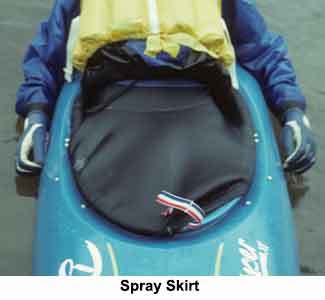 comfortable is made of neoprene, the same material used in wet suits, but nylon skirts also are available. Spray skirts with a rubber gasket provide a particularly tight seal around the cockpit to prevent water from entering the boat. Skirts are available in different waist sizes, and in the case of those with a gasket, they are also available in different cockpit sizes.
comfortable is made of neoprene, the same material used in wet suits, but nylon skirts also are available. Spray skirts with a rubber gasket provide a particularly tight seal around the cockpit to prevent water from entering the boat. Skirts are available in different waist sizes, and in the case of those with a gasket, they are also available in different cockpit sizes.
Those with shock cords are adjustable for differently sized cockpits, which is convenient if you will be paddling different kayaks. A double waisted spray skirt in which one waist goes under the lower flap of a dry top and one goes over, makes a particularly good seal.
All spray skirts should have a strap or cord on the outside that can be pulled to detach the spray skirt from the rim if it does not pop off when the boater is forced to eject himself from the kayak. Jamming normally is not a problem, but with any spray skirt, try it out several times to be sure it releases without a hitch.
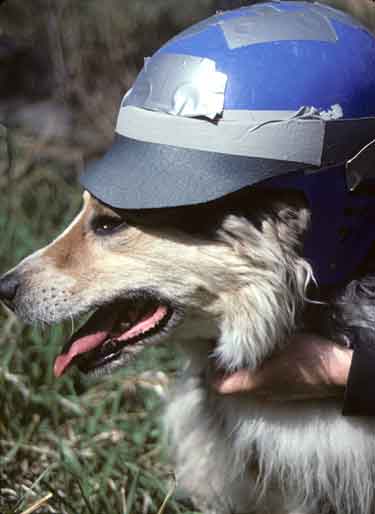 Helmets
Helmets
Helmets are a must for kayaking. When a kayaker flips upside down, his head is exposed to rocks before he rolls. In addition, a kayaker swimming a rapid requires head protection. A friend of mine tipped upside down in a very shallow rapid in low-water conditions. From above, I watched his upside-down kayak jerk up and down as his helmet banged over boulders on the river bottom. He eventually got out of his kayak and stood up in water shallower than his knees. Because of his helmet, he did not have a bruise or scrape. Helmets are increasingly being worn as a safety precaution by canoeists and rafters in tricky water.
When choosing a helmet for whitewater use, the following are some points to keep in mind:
-
Choose a helmet that has a lining of crushable foam or closed-cell foam at least one-half-inch thick with up to an inch providing even more protection
-
Many boaters advise against helmets with large holes in the shell, such as in the old-style hockey helmets once used for whitewater. Dick Held was on a trip where a stick penetrated one of the holes in the helmet of a kayaking companion, badly cutting him so that he needed stitches.
-
The helmet should protect the forehead, temples, ears, and back of the head. Charles Walbridge, safety chairman of the American Canoe Association, explains that impact with river obstructions most likely will occur to the side of the head rather than directly to the top.
-
The helmet should be comfortable and snug, and should not tend to come off the boater's head when he is doing rolls.
Flotation Bags
Whitewater canoes and kayaks need flotation or they will sink. A variety of types of waterproof bags are available to provide flotation. For canoeing, large flotation bags are placed fore and aft. In addition to providing flotation, the bags help shed splashing waves, cutting down on the amount of water getting in the boat.
Kayaks with foam pillars require a set of four narrow bags. Two bags fit on either side of the pillar in the rear of the kayak and two fit on either side of the front pillar. One special type of flotation bag, called a storage flotation bag, has an opening in which you stuff your gear for overnight or day trips. When sealed, the bag keeps the gear dry and provides flotation. I really recommend buying the storage type of flotation bag, since even for day trips it's nice to carry some extra warm clothing with you. With a storage bag you can do that.
Flotation bags are available in lightweight nylon or vinyl. The vinyl bags are cheaper, but the draw back is that they can be easily damaged. I have had lots of trouble with them and it's nearly impossible to fix a leak on the seam. If you have a pair, treat them like a baby.
Break down Paddles
On any kayak trip, it is a good idea to have one or more spare paddles available in your group. If you are not supported by rafts, it will be necessary to carry the spare paddle in the kayak special break-down paddles that detach in the middle are made for this purpose.
Other Whitewater Craft
Open Canoes. Increasing numbers of boaters have been pushing the limits of canoeing to an extent never believed possible. Even the Colorado River has been run in open canoes. The new ABS/Royalex and polyethylene canoes are extremely durable, and can be popped back in shape if dented.
Canoes for whitewater should have high enough sides to keep large amounts of water from splashing inside. Some canoeists recommend fifteen-inch sides for whitewater. The bottom of the boat should not have raised keel strips and needs some amount of rocker for good turning. The canoe should provide a bracing system so the canoeist can be secured in the boat, but also to be able to escape easily if the boat capsizes. Thwarts or seats should not be placed so low as to trap the feet. Finally, a canoe for whitewater should have extra flotation. Special large flotation bags are made for canoes--and some boaters even use large blocks of foam placed in the middle of the canoe.
These are just a few suggestions I will leave discussion of canoe techniques to those much more qualified than I. Two excellent sources are The Complete Wilderness Paddler by James Dividson and John Rugge and the superbly illustrated Path of the Paddle by Bill Mason.
Paddle Boards. Another more recent development are paddle boards which have seen a swell of interest for use on flat water. A paddle board looks something like surf board and is paddled with a long, single bladed paddle. There are two basic types: solid or inflatable. While most people are content using them on lakes and slow moving rivers (yoga is even practiced on paddle boards), there is contingent of paddle boaders which test their skills on whitewater. A whole book can be written about paddle boarding and whitewater, but for this chapter we'll stick to canoes and kayaks.
Folding kayaks
Folding kayaking were developed in Germany where people needed a portable boat that could be packed in a bundle and carried with them on trains to the river. Single and double kayaks are available, with the single kayak being more suited to whitewater. People have pushed harder rapids in folding kayaks, but class II and III waters are, in most cases, the limit. Generally, these craft are more suited to easy rapids and flat water.
Inflatable Kayaks and Canoes
Inflatable kayaks are surprisingly are very stable boats. Unlike a kayak or canoe, one can jump into an inflatable without much prior experience and do reasonably well in easy rapids. They are, however, sluggish, poor at turning into eddies, and not nearly so maneuverable in rapids as a hard-shelled kayak or decked canoe

